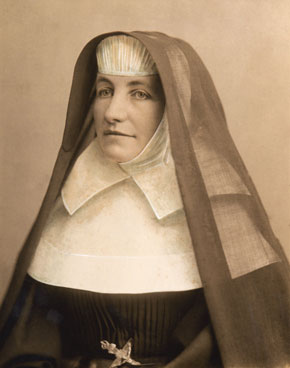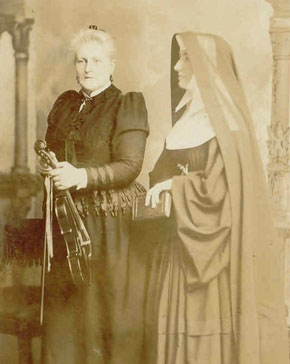![[thumbnail] Charlotte Fitzpatrick rsm](../_uploads/resources/authors/214-e851dfb8/9481A3E9-B25F-5334-912C8A7EA4769AD9.jpg)
Charlotte Fitzpatrick rsm
is a Sister of Mercy living in St. John’s, Newfoundland & Labrador, Canada. Her ministry experience has included teaching, formation and congregational leadership . She is currently co-director of The Gathering Place, a community service center in St. John’s, founded in 1994 as a joint project of the Sisters of Mercy and the Presentation Sisters. In 2011 Sister Charlotte wrote Woman of Providence, the story of Sister Mary Antonio Egan, foundress of the first Convent of Mercy on Newfoundland’s west coast.

 Sister Mary Antonio Egan, the founder of the first Convent of Mercy on Newfoundland’s west coast, would have undoubtedly nodded in agreement at poet David Whyte’s wise comment on life. The call of the mission in the late nineteenth century took her from the comfortable academic and cultural milieu of convent life and ministry in Providence, Rhode Island, to a foreign, harsh environment with very rudimentary educational and social structures. It was in this environment of hardship and struggle in Bay St. George, Newfoundland, that Sister Mary Antonio and her companions gave birth to a dream that would change their lives and the lives of all who were touched by their ministry of Mercy.
Sister Mary Antonio Egan, the founder of the first Convent of Mercy on Newfoundland’s west coast, would have undoubtedly nodded in agreement at poet David Whyte’s wise comment on life. The call of the mission in the late nineteenth century took her from the comfortable academic and cultural milieu of convent life and ministry in Providence, Rhode Island, to a foreign, harsh environment with very rudimentary educational and social structures. It was in this environment of hardship and struggle in Bay St. George, Newfoundland, that Sister Mary Antonio and her companions gave birth to a dream that would change their lives and the lives of all who were touched by their ministry of Mercy. It was Father Sears’ successor and friend, Reverend Michael Francis Howley, who would bring a community of nuns to Newfoundland’s west coast. A highly intelligent, energetic and visionary man, Michael Francis Howley became Prefect Apostolic of the west coast of the island in 1885, Sandy Point being the seat of the Prefecture. Full of ideas and zeal for the advancement of his extensive mission, Bishop Howley realized that his starting point and focus had to be the promotion of education and religion throughout the area. Like his predecessor, Father Sears, he saw the importance of a community of Sisters to help him carry out his missionary goals.
It was Father Sears’ successor and friend, Reverend Michael Francis Howley, who would bring a community of nuns to Newfoundland’s west coast. A highly intelligent, energetic and visionary man, Michael Francis Howley became Prefect Apostolic of the west coast of the island in 1885, Sandy Point being the seat of the Prefecture. Full of ideas and zeal for the advancement of his extensive mission, Bishop Howley realized that his starting point and focus had to be the promotion of education and religion throughout the area. Like his predecessor, Father Sears, he saw the importance of a community of Sisters to help him carry out his missionary goals. Sister Mary Antonio, born Elizabeth Egan in England on May 12, 1852, came with her father, brothers and sister to the United States at an early age to live with an aunt. She attended St. Xavier’s Convent School, a private school begun by the Sisters of Mercy in Providence in 1856. She entered the community at St. Xavier’s in May,
Sister Mary Antonio, born Elizabeth Egan in England on May 12, 1852, came with her father, brothers and sister to the United States at an early age to live with an aunt. She attended St. Xavier’s Convent School, a private school begun by the Sisters of Mercy in Providence in 1856. She entered the community at St. Xavier’s in May,